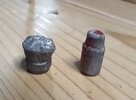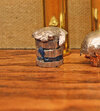barnfrog
Member
The picture below is of two bullets shot into a bullet trap consisting of a bucket of sand with rubber matting held across the mouth. Range was 25 yards. The one on the right is an Acme .358 Hi-Tek coated 158-grain SWC (I think; I bought them from another forum member). If it is in fact an Acme bullet, it is BHN 16. I load these with 5.0 grains of Universal, resulting in a muzzle velocity from my Model 19 of around 825 fps, give or take. The bullet on the left is an MBC .411 Hi-Tek coated 215-grain SWC (I know it is; I bought them from MBC). Those are loaded with 15.3 grains of 2400 and are traveling about 1100 fps when they leave the barrel of my Model 57.
I thought it was very interesting to see the vastly different amounts of expansion, which I assume are primarily due to the velocity differential since the bullets are pretty similar in hardness. The .41 Mag expanded to .51" or about 25% at its widest point, while the smaller but slightly softer bullet hardly expanded any, if at all. I would have thought the .358" bullet would expand a little bit at least.
This of course does not tell me anything about how either would perform when used on game, only how they perform relative to each other at these speeds in this medium. Intuitively, it seems like expansion would be greater when shot into a pile of sand than when shot into soft living tissue, but I'm no terminal ballistician. Hitting bone would of course alter things, too.
No great revelations here. Just made me go hmmmmm.

I thought it was very interesting to see the vastly different amounts of expansion, which I assume are primarily due to the velocity differential since the bullets are pretty similar in hardness. The .41 Mag expanded to .51" or about 25% at its widest point, while the smaller but slightly softer bullet hardly expanded any, if at all. I would have thought the .358" bullet would expand a little bit at least.
This of course does not tell me anything about how either would perform when used on game, only how they perform relative to each other at these speeds in this medium. Intuitively, it seems like expansion would be greater when shot into a pile of sand than when shot into soft living tissue, but I'm no terminal ballistician. Hitting bone would of course alter things, too.
No great revelations here. Just made me go hmmmmm.



